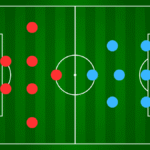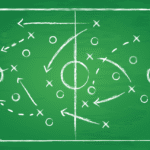Soccer tactics have undergone a revolutionary transformation in the past decade, with innovative formations and playing styles redefining what’s possible on the pitch. This 2,000-word tactical deep dive explores how cutting-edge strategies are shaping today’s game and what we can expect in the coming years.
⚽ The Tactical Revolution: From Static to Fluid Systems
The Decline of Traditional Formations
Gone are the days of rigid 4-4-2 setups. Modern soccer has seen:
-
Positional play replacing fixed roles
-
Fluid formations that morph during matches
-
Hybrid player roles (fullback-wingers, striker-playmakers)
Key Stat: The average player now covers 12% more ground per match than in 2010
Current Dominant Formations Explained
1. The 4-3-3 (Pep Guardiola’s Blueprint)
-
Used by: Manchester City, Barcelona, Liverpool
-
Key Features:
-
False nine creating overloads
-
Inverted fullbacks tucking into midfield
-
High press with coordinated triggers
-
2. The 3-2-4-1 (Chelsea’s Innovation)
-
Pioneered by: Thomas Tuchel, now used globally
-
Why It Works:
-
Creates numerical superiority in buildup
-
Allows wingbacks to dominate flanks
-
Provides defensive stability with back three
-
3. The 4-2-3-1 (Most Versatile System)
-
Modern Adaptations:
-
Double pivot screening defense
-
Attacking midfielder given complete freedom
-
Overlapping fullbacks creating width
-
Tactical Trends by League (2024 Analysis)
| League | Dominant Formation | Unique Feature |
|---|---|---|
| Premier League | 4-3-3 | Extreme high press |
| La Liga | 4-2-3-1 | Positional play |
| Bundesliga | 3-4-3 | Counter-pressing |
| Serie A | 3-5-2 | Low defensive block |
Positional Evolution: New Roles Emerging
1. The Inverted Fullback
-
Examples: Trent Alexander-Arnold, João Cancelo
-
Duties:
-
Play as auxiliary midfielders
-
Create overloads in central areas
-
Launch diagonal switches
-
2. The False Nine
-
Modern Masters: Lionel Messi, Kai Havertz
-
Impact:
-
Drags center-backs out of position
-
Links midfield and attack
-
Creates space for wingers
-
3. The Ball-Playing Sweeper Keeper
-
Trailblazers: Ederson, Manuel Neuer
-
Revolutionary Effect:
-
Acts as extra outfield player
-
Starts attacks with 60+ yard passes
-
High defensive line enabler
-
Statistical Impact of Modern Tactics
Game-Changing Metrics
-
Possession: Top teams now average 65%+ (up from 55% in 2010)
-
Pressures: 200+ per game for pressing teams
-
Passing: 600+ passes per match becoming standard
Position-Specific Changes
| Position | 2010 Stats | 2024 Stats |
|---|---|---|
| Fullbacks | 40 passes/game | 75 passes/game |
| Center Mids | 5km covered | 7.5km covered |
| Wingers | 3 crosses/game | 5 dribbles/game |
Masterminds Behind the Revolution
1. Pep Guardiola
-
Innovations:
-
Positional rotation
-
Build-up through goalkeeper
-
Half-space exploitation
-
2. Jürgen Klopp
-
Contributions:
-
Gegenpressing perfected
-
Fullback creativity unleashed
-
High-intensity transitions
-
3. Roberto De Zerbi
-
New Ideas:
-
Third-man combinations
-
Purposeful ball-playing under pressure
-
Dynamic shape-shifting
-
Future Tactical Trends (2025 and Beyond)
1. Positionless Soccer
-
Players constantly interchanging roles
-
AI-assisted real-time formation changes
-
Complete fluidity between defense and attack
2. Set Piece Revolution
-
Increasing focus on dead-ball situations
-
NBA-style designed plays
-
30% of goals expected from set pieces by 2026
3. Data-Driven Substitutions
-
Algorithmic determination of optimal changes
-
Fatigue management through biometrics
-
Tactical shifts based on live analytics
Why Tactical Evolution Matters
Modern soccer tactics have:
✅ Made games more entertaining
✅ Increased scoring opportunities
✅ Demanded higher athleticism
✅ Created more specialized roles
✅ Enhanced the cerebral aspect of coaching
For more tactical analysis, visit SoccerNewsZ




No comment